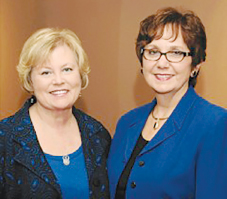Thirteen years ago, Stephanie Koraleski, PhD, an oncology psychologist, and Kay Ryan, PhD, RN, a cardiac nurse and breast cancer survivor, in Omaha, brought together colleagues in the fields of clinical research, nursing, nutrition, mental health, physical therapy, pharmacy, and spirituality to build a cancer rehabilitation program that incorporated a holistic approach to survivorship to fill a care gap left after treatment ends.

Kay Ryan, PhD, RN and Stephanie Koraleski, PhD
“At the time, I was working in a cancer center and was also a liaison with a cardiac program in a nearby hospital,” said Dr. Koraleski. “I noticed that patients diagnosed with cardiac disease and stroke had access to rehabilitation programs staffed by a multidisciplinary team of medical professionals to help them regain their mental and physical functional abilities, but there was nothing similar for patients with cancer. On the last day of treatment, we give cancer survivors a hardy handshake and a pat on the back and tell them, ‘See you in 3 months.’ We leave them on their own to get back to their lives and work.”
After meeting with cancer survivors to learn what their physical and mental health needs were posttreatment and conducting a massive literature search to gather research on the best health-care strategies proven to be effective in cancer survivors, Drs. Koraleski and Ryan, along with their colleagues, launched A Time to Heal in 2005, with a grant from Susan G. Komen Nebraska. Initially developed for breast cancer survivors living in Omaha, the 12-week program, offered for free to survivors and their caregivers, is now open to both men and women with any type and stage of cancer. Available in 13 cities throughout Nebraska, it has expanded to cities in Iowa, Kansas, Wisconsin, Ohio, and South Dakota.
Creating the Best Life After Cancer
THE 36-HOUR program is comprehensive, offering 12 weekly sessions in building resilience, learning meditation and relaxation techniques, coping with sexual dysfunction and other cancer-and treatment-related side effects, self-nurturing, overcoming fear of recurrence, sharing dietary and exercise recommendations to regain health and energy, relationship and spirituality building, guiding the use of supplements, forging a path forward, and regaining happiness.
“We were surprised to find that every area of survivors’ lives improved after going through the program and that they are happier and more hopeful.”— Stephanie Koraleski, PhD
Tweet this quote
The program, which completely relies on trained professional volunteers, usually a nurse and a mental health professional, to staff each session, costs about $100 per program participant—excluding the cost of facilitator training. This fee is offset by grants from cancer foundations and donations from participating hospitals and private individuals. Since its launch, A Time to Heal has served several thousand survivors and their caregivers.
“A lot of our motivation for launching A Time to Heal was to teach survivors to focus on their lives as they are now and create their best lives moving forward. We want people to get back the personal priorities they may have lost after their cancer diagnosis,” said Dr. Koraleski, the current President of the Board of A Time to Heal. “Our program creates space for survivors to determine what aspects of their lives they want to keep, which ones they want to discard, and what gives their life meaning and happiness.”
Measuring Success
TO EVALUATE the effectiveness of the cancer rehabilitation program, Dr. Koraleski and her colleagues launched a research study among over 900 of its participants at 17 urban and rural program sites in 5 states. Most program participants were survivors of breast cancer (87%), followed by survivors of ovarian/gynecologic cancer, and two-thirds of participants had been diagnosed with stage I or II cancer. Program participants were asked to rate a list of questions measuring their level of hope, happiness, overall function, depression, anxiety, somatization, and posttraumatic growth at 4 intervals in the program: 1 to 3 months prior to the start of the program; week 1 of the program; the last session of the program; and 6 months after the end of the program.
The results, which are being reviewed for publication, found that every area measured showed improvement, and the improvement was long-lasting. The data also found that all program sites had similar results, indicating the program is reproducible in both rural and urban settings.
“We were surprised to find that every area of survivors’ lives improved after going through the program and that they are happier and more hopeful. Our goal was to make a difference, and we are delighted to see that this work does make a difference in these survivors’ lives,” said Dr. Koraleski. ■
DISCLOSURE: Dr. Koraleski reported no conflicts of interest.

